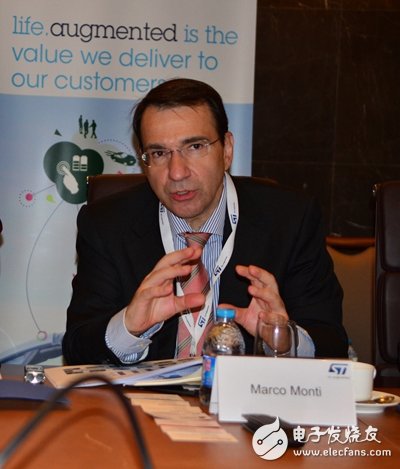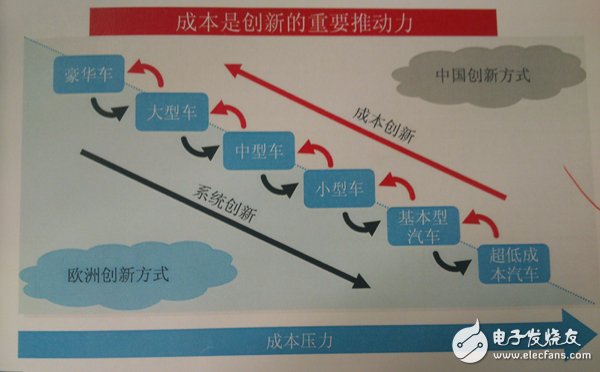What do you think of the Chinese automotive electronics market in the eyes of ST?
The characteristics of the Chinese automotive market understood by STMicroelectronics (ST) can be summarized in four adjectives-high-speed growth, high decentralization, short R & D cycle, and great innovation.
In this regard, ST Executive Vice President Francois Guibert explained the following: China's auto market is a fast-growing and dynamically changing market. It is necessary to fully understand the needs of local automakers' customers, respond quickly and launch tailor-made products. If you want to gain a foothold in such a market, if you don't pay attention to local needs and you don't have innovation, there will be no scale.

ST senior elite interpretation of cost innovation in China's automotive electronics market
——Marco Mario MonTI, General Manager of ST Automotive Products Division——The Chinese market drives innovation at low cost, not at the expense of quality and lowering standards

Aiming at the fact that Chinese automakers have completed the development of new cars in half of the European R & D cycle, and have been questioned by the industry about "automotive safety, reliability and low specifications", Marco Mario MonTI, General Manager of ST Automotive Products Division, expressed his opinion- The new car development cycle of Chinese manufacturers is different from that of Europe. It is not a compromise in safety, but a step-by-step approach in innovative ways. This kind of innovation does not happen overnight, but gradually improves and reduces costs from generation to generation. Although China's automotive qualification certification standards are not stricter than European standards, the gap is gradually narrowing, and there are no gaps in certain areas, such as automobile engines and engine management.

A three-step strategy for Chinese-style innovation-Chinese automakers reduce costs through innovation, not at the expense of quality and lower standards.
MonTI emphasizes that the Chinese market can drive innovation at low cost, which is not feasible in Europe. It can be clearly seen from the figure below that the difference between Chinese innovation and European innovation: China is driven by cost-driven innovation from bottom to top, and Europe is systematic innovation from top to bottom.

China's innovation is driven by cost, innovation is bottom-up, Europe is system innovation, top-down
Because in Europe, the service life of cars is generally 5-6 years. After the service life expires, they generally only make some changes in appearance, and the platform system remains basically unchanged. The cycle in the United States will be longer, about 8 years.
In China, new models are launched every 2-3 years, so Chinese automakers must gradually innovate in an accelerated manner. Take an example to illustrate: In China, many modules are tailor-made solutions. Because of the quantity guarantee, the cost can be very low, and China also has cost advantages in manufacturing and industrial chain.
However, in Europe, due to demand, it is impossible to customize modules for a single car series, but one module meets the requirements of multiple different models, leaving a lot of design redundancy, and the car manufacturer must also be redundant Paid. Of course, some changes are also taking place in Europe. The development time of 5-6 years can be tolerated by top automakers. For ordinary automakers, this cycle is still too long. They also hope that semiconductor suppliers can help them Quickly achieve innovation, and quickly implement these innovative solutions into the vehicle development and R & D process in order to adapt to this change in the entire market.
Hotel Humidifier
Hotel Humidifier brings the feeling of fresh spring air to your hotel room, especially in winter.
Hotel guests expect that temperature and humidity in their hotel room, in the swimming pool area and the spa to be at a healthy and comfortable level. The right level of relative humidity during the heating season improves the well-being of your guests. A relative humidity between 40 and 60% RH means a comfortable indoor climate.
During the winter heating season, the relative humidity is often below 30%. Low humidity levels affect the well-being and health of your guests. Without humidification, susceptibility to illness and disease is substantially increased.
The reason: aerosols containing viruses remain airborne longer when humidity is low, significantly increasing the risk of transmission, and a dry nose, throat and skin mean the body`s natural resistance is reduced.
DITUO Oil Humidifier are commonly used to increase indoor humidity, or the level of moisture in the air. Primarily used in the winter months, due to indoor heating systems and cold temperatures lead to low humidity levels. The use of a Room Humidifier in these drier months can have numerous health benefits. DITUO Whole House Humidifier help in reducing dry skin and chapped / dry lips during the winter months.
Hotel Humidifier
Oil Humidifier,Hotel Humidifier,Room Humidifier,Whole House Humidifier
Shenzhen Dituo Electronic Co.,Ltd. , https://www.sz-dituo.com